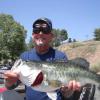For your first question, I use two ways to increase buoyancy.
First, I increase buoyancy by drill holes in the top/back of my baits, and gluing discs from aluminum cans over them, to trap air inside and I cover the discs with a thin coat of bondo, so I can sand the bondo down to follow the bait's contours. When I'm done sanding/shaping, I add a drop or two of runny super glue to strengthen the bondo disc patch area.
Second, I actually use the natural buoyancy of the bait's material, because I use either wood or PVC trim board to make my baits from. I shape my baits with a V cross section, like the cross section of a battleship, so there is more buoyant material higher in the bait. That way I can add less ballast and still get a stable bait that is lighter and more active. Plus that shape keeps the bait from rolling or blowing out on a fast retrieve.
As to the second question, I've found that the wider the body and the wider the bill, the wider and more exaggerated the wobble. The reverse is also the case. A flatter sided body and narrower bill will have less wobble. That's why most commercial flat sided cranks also have narrower bills.
As far as how modifying your bait will affect it, every bait is different. When I modify a bait, I do it one thing at a time, so I can see what works, and know that I will ruin some bait in the process. I also use unpainted cheap knockoff blanks to do my experimenting on, so I'm not out a lot of money if they get ruined.
I hope this helps.









